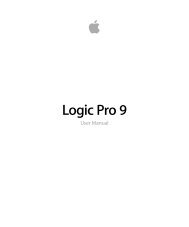Soundtrack Pro 3 Effects Reference (en).pdf - Help Library - Apple
Soundtrack Pro 3 Effects Reference (en).pdf - Help Library - Apple
Soundtrack Pro 3 Effects Reference (en).pdf - Help Library - Apple
You also want an ePaper? Increase the reach of your titles
YUMPU automatically turns print PDFs into web optimized ePapers that Google loves.
By reducing the highest parts of the signal, called peaks, a compressor raises the overall<br />
level of the signal, increasing the perceived volume. This gives the signal more focus<br />
by making the louder (foreground) parts stand out, while keeping the softer background<br />
parts from becoming inaudible. Compression also t<strong>en</strong>ds to make sounds tighter or<br />
punchier because transi<strong>en</strong>ts are emphasized, dep<strong>en</strong>ding on attack and release settings,<br />
and because the maximum volume is reached more swiftly.<br />
In addition, compression can make a project sound better wh<strong>en</strong> played back in differ<strong>en</strong>t<br />
audio <strong>en</strong>vironm<strong>en</strong>ts. For example, the speakers of a television set or in a car typically<br />
have a narrower dynamic range than the sound system in a cinema. Compressing the<br />
overall mix can help make the sound fuller and clearer in lower-fidelity playback<br />
situations.<br />
Compressors are typically used on vocal tracks to make the singing promin<strong>en</strong>t in an<br />
overall mix. They are also commonly used on music and sound effect tracks, but they<br />
are rarely used on ambi<strong>en</strong>ce tracks.<br />
Some compressors—multiband compressors—can divide the incoming signal into<br />
differ<strong>en</strong>t frequ<strong>en</strong>cy bands and apply differ<strong>en</strong>t compression settings to each band. This<br />
helps to achieve the maximum level without introducing compression artifacts.<br />
Multiband compression is typically used on an overall mix.<br />
• Expanders: Expanders are similar to compressors, except that they raise, rather than<br />
lower, the signal wh<strong>en</strong> it exceeds the threshold. Expanders are used to add life to audio<br />
signals.<br />
• Limiters: Limiters—also called peak limiters—work in a similar way to compressors in<br />
that they reduce the audio signal wh<strong>en</strong> it exceeds a set threshold. The differ<strong>en</strong>ce is<br />
that whereas a compressor gradually lowers signal levels that exceed the threshold, a<br />
limiter quickly reduces any signal that is louder than the threshold, to the threshold<br />
level. The main use of a limiter is to prev<strong>en</strong>t clipping while preserving the maximum<br />
overall signal level.<br />
• Noise gates: Noise gates alter the signal in a way that is opposite to that used by<br />
compressors or limiters. Whereas a compressor lowers the level wh<strong>en</strong> the signal is<br />
louder than the threshold, a noise gate lowers the signal level wh<strong>en</strong>ever it falls below<br />
the threshold. Louder sounds pass through unchanged, but softer sounds, such as<br />
ambi<strong>en</strong>t noise or the decay of a sustained instrum<strong>en</strong>t, are cut off. Noise gates are oft<strong>en</strong><br />
used to eliminate low-level noise or hum from an audio signal.<br />
42 Chapter 3 Dynamics <strong>Pro</strong>cessors
















